Buoyant Economies
Evidence on Quantitative Easing
Quantitative easing (QE) has not increased lending. It may have had some positive effects on income and employment. However, these positive effects are more likely to have been attributable to the growth of the government’s fiscal deficit which raised public debt from 57% of GDP in 2008 to 73% of GDP in 2009.
At a time when the public at large is overburdened with debt and is reluctant to take on more debt, the banking system proposes solutions that increase debt. Such solutions benefit the banks, not the economy as a whole.
To explain the causes of the debt crisis in the UK and the effect of policies such as QE, this submission first considers the effects of two basic sources of money in an economy: increased foreign reserves and bank credit.
Foreign sources of money
To assess the first source, foreign reserves, it necessary to assume that the only source of money is from increased foreign reserves and that exchange rates are fixed. In this situation, additional currency is created when exporters repatriate their foreign income. The banking system accepts the foreign currency, and in exchange provides additional domestic currency. The foreign currency is an asset of the banking system and is added to the foreign reserves of the banking system. The bank deposits, bank notes and coins, that the banking system issues in exchange, are the liabilities of the banking system.
The banking system converts domestic currency back into foreign currency when the economy pays for imports. While the only source of money continues to be from the growth of foreign reserves, the banking system will always hold sufficient foreign reserves to meet this demand for foreign currency. Foreign payments reduce not only the foreign reserves (the assets) of the banking system; they also reduce the money in circulation.
The foreign reserves of the banking system are a form of national savings. The exporters who earned the foreign currency may not treat their income as savings. However, while the money they earned from exports is circulating within the economy and is not spent on imports, as far as the rest of the world is concerned, the economy has increased its savings.
It is worth noting that under this monetary arrangement that, unless it borrows directly from foreign sources, the economy accumulates foreign reserves and not foreign debt.
Domestic source of money
The second source of money is bank credit. When the banking system lends, it issues additional money, usually in the form of bank deposits. These bank deposits are liabilities of the banking system. The corresponding assets of the banking system are the loans of the debtors.
When people and businesses spend the money generated by bank credit on imports, the banking system converts their domestic currency into foreign currency. These foreign payments reduce the foreign reserves of the banking system in the same way as money that was created from exports. But the money from bank credit did not initially increase foreign reserves. Therefore, when this money is spent on imports, it depletes the foreign reserves of the banking system.
Floating exchange rate
The floating exchange rate system was introduced in response to excessive growth in bank credit that severely depleting the foreign reserves of the banking system. The floating exchange rate system protects the foreign reserves of the banking system. It requires that international receipts and payments are equal, thereby ensuring that international transactions do not affect the foreign reserves of the banking system.
When banks create excessive amounts of bank credit, they raise the demand for imports. In theory, under the floating exchange rate system, the foreign exchange market would devalue the currency, making imports more expensive and raise export incomes. In this way, the floating exchange rate system is expected to rebalance trade.
The floating exchange rate has protected the foreign reserves of the banking system. However, it has not balanced trade. To understand why, it is necessary to return to the most basic concept of trade; reciprocity.
Banking and reciprocal trade
In the most basic form of trade, without money, people trade by exchanging products; that is by barter. When we introduce money into this market, people sell products in exchange for money and the money they earn entitles them to buy products of an equivalent value to that which they sold. In this way, money preserves the reciprocal nature of trade.
It is very important that the monetary system be secure. If someone were to issue counterfeit money, they would be able to buy products without reciprocating: they would be stealing products from the market. It is for this reason that money in the form of bank notes is printed with a number of security features designed to minimise the possibility of counterfeit money being produced.
The bulk of the money supply in the economy is held as bank deposits. The Bank of England would close down a bank that persisted in creating money by increasing the amount shown as being deposited in the accounts of its executive and staff. That would be akin to forgery, stealing from the market economy. Similarly, the Bank of England would close down a bank that persisted in creating money by increasing the amount shown as deposited in the accounts of its customers. That would allow the bank’s customers to steal from the market.
As we have already noted above, the banking system increases the amount of money deposited in the accounts of their customers when they make new loans. These additional deposits enable the borrowers to buy more than they have produced. When borrowers repay their loans, they are reciprocating. But until the borrower has reciprocated, the banking system has facilitated, in effect, the theft of products from the market economy.
Bank lending and the current account deficit
Banking statistics show that total bank lending has been rising. Therefore, although individual borrowers may reciprocate, the banking system continues to finance expenditure that exceeds the expenditure generated in the market by reciprocal trade. The only way that additional products can be supplied (outside that generated by reciprocal trade) is for imports to exceed exports by the amount of the growth in bank lending.
The Reserve Bank of New Zealand publishes statistics on the amount of money generated from domestic sources (M3R). Figure 1 plots the growth of M3R money and the New Zealand current account deficit[1]. It reveals how the growth of bank credit has generated imports is excess of exports and therefore caused current account deficits. To pay for those additional imports, the economy must sell its capital assets, or raise foreign debt.
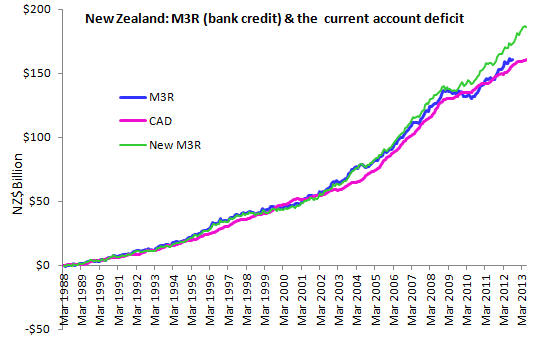
Figure 1. New Zealand: Money from domestic sources (bank credit) and the current account deficit (Source of data: Reserve Bank of New Zealand)
Floating exchange rate, production and money
Not only does the floating exchange rate system prevent the growth of bank credit from depleting the foreign reserves of the banking system, it also prevents exports and other foreign income from generating additional foreign reserves and contributing to the domestic money supply. Instead, when exports increase, the exchange rate appreciates to make people shift their spending from domestic products to the now cheaper imports. Therefore, domestic industries supplying the domestic market suffer a decline in demand, reducing production. Also, the higher exchange rate reduces the incomes of exporters.
The additional money spent on imports provides the foreign exchange market with the domestic currency required to pay for the growth in exports. In this way, international transactions do not affect the banking system’s foreign reserves.
This also means that when the banking system increases credit and the money supply, there are no national savings to offset the additional demand for imports. Therefore, all of the growth in bank credit generates imports in excess of exports, as was evident in Figure 1.
When economies allow monetary growth from international trade, they generate savings that can fund the imports financed by the growth of bank credit. Figure 2 reveals that between the December 2000 quarter and the June 2004 quarter, India experienced current account surpluses. These surpluses coincide with the period in which the Reserve Bank of India intervened in the foreign exchange market. During the other times, India applied the floating exchange rate system and during those times, its current account deficits were equal to the amount of currency in circulation.
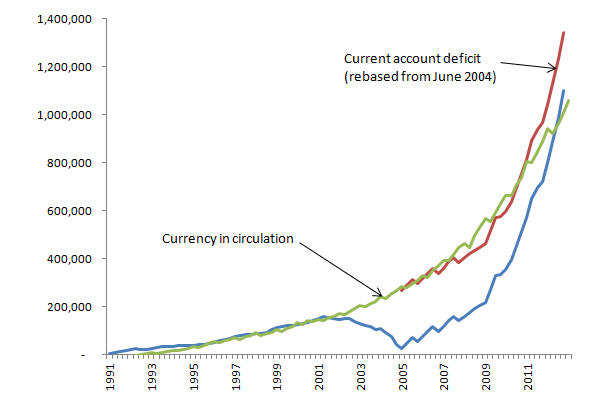
Figure2. India: Currency in circulation and the current account deficit (Source: Reserve Bank of India)
As discussed above, the floating exchange rate isolates the domestic money supply from the effect of international transactions. This is often referred to as a benefit of the floating exchange rate system as it provides monetary independence. However, it also means that the only source of monetary growth is from the growth of bank credit. Therefore, the economy is dependant for its monetary growth upon a source of money that raises foreign debt, as well as domestic debt.
If the floating exchange rate system were working, as theorised, to depreciate the exchange rate in response to excessive growth in bank credit, we would expect that the share of GDP spent on imports to decline over time. Alternatively, if export growth were inflating the exchange rate, we would expect the share of GDP being spent on imports to be rising.
Figure 3 shows the ratio of imports and exports to GDP for the UK. It reveals that expenditure on imports has increased from 24% of GDP in 1991 to 34% in 2011. Therefore, export growth has been driving up the effective value of the pound sterling, reducing the income of exporters and reducing the incomes of import competing industries.
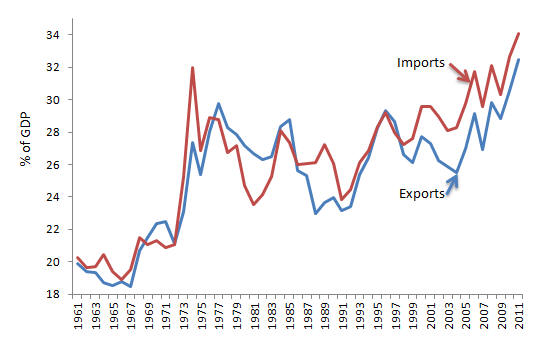
Figure 3. UK share of GDP spent on imports and earned from exports (Source: World Bank)[2]
While the floating exchange rate system may have been successful in protecting the Bank of England’s foreign reserves, it would appear that this protection has been provided at great cost to the economy, particularly over the last 20 years. It is questionable whether the exchange rate should be used for such a limited objective when it has such a profound effect upon the productive side of the economy, undermining its international competitiveness.
The growth of domestic debt
While the finance and banking industry has prospered over most of the last forty years, the remainder of the economy has not. Figure 4 shows the ratio of domestic credit provided by the banking sector to GDP. In the 1960s and 1970’s, the ratio of bank credit to GDP was stable at around 50% of GDP. Since the early 1980’s, bank credit has been growing as a share of GDP, peaking at 228% of GDP in 2009. Between 1980 and 2009, bank credit grew more than 6 times faster than the economy.
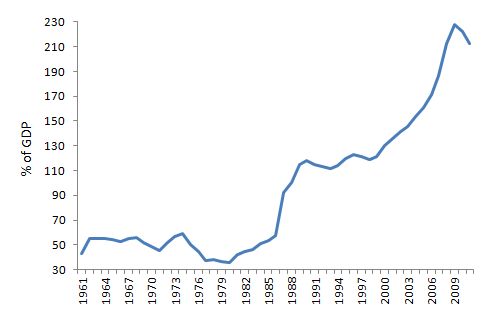
Figure 4. UK: Domestic credit provided by the banking sector as % of GDP (Source: World Bank)[3]
GDP also signifies the capacity of the economy to repay its debts. The high rate of growth of bank credit relative to the growth of the whole economy means that debt has been growing faster than the capacity of the economy to repay its debts. This is an unsustainable state of affairs. Eventually, the debt must reach, or exceed, the capacity of the economy to repay that debt. If bank credit is permitted to exceed the capacity of the economy to repay, it is inevitable that a financial crisis will follow in which debtors would not be able to repay their loans and the banks will face insolvency. Therefore, the policies that have enabled the banking system to grow rapidly and make large profits could bring about its downfall.
If the economy of the UK in 2009 was fully saturated with debt, then quantitative easing (QE) would not have addressed the problem. Rather, if it had succeeded in raising the level of borrowing, it would have contributed to the problem.
Figure 5 presents the growth of lending by monetary institutions (mainly banks) since 2003. It reveals that QE did not lead to any growth in lending, although that was its main objective. Rather, it resulted in an immediate reduction in the growth of lending. Given that the British economy may be fully saturated with debt, a reduction in bank lending may have been a desirable outcome.
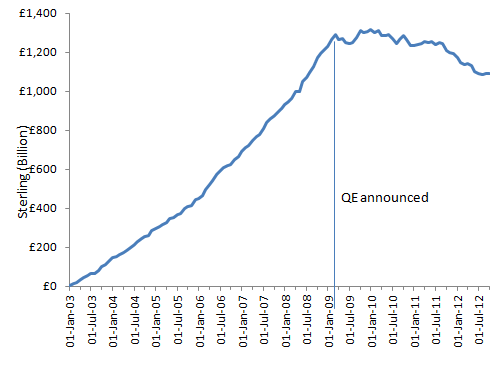
Figure 5. Growth of M4 Lending -monetary institutions net lending to the private sector (Source: Bank of England)
Figure 6, suggests that QE may have halted the decline in GDP. Within two quarters of QE being introduced, real GDP starts to rise again. However, the rate of growth of GDP has average less than 1% per annum, since QE was announce. QE has not been capable of significantly raising the rate of economic growth. The economy needs a far more effective means of raising GDP.
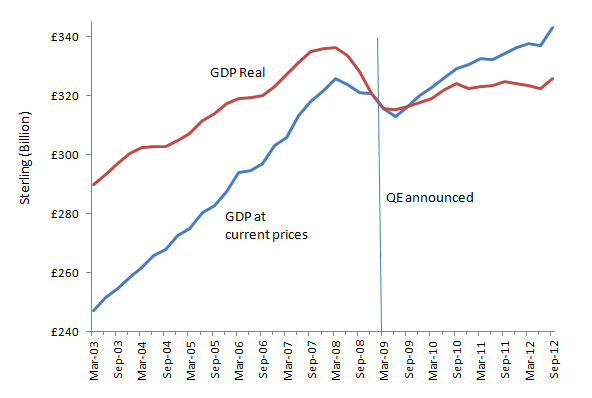
Figure 6. GDP per quarter at current prices and chained volume measures (real)
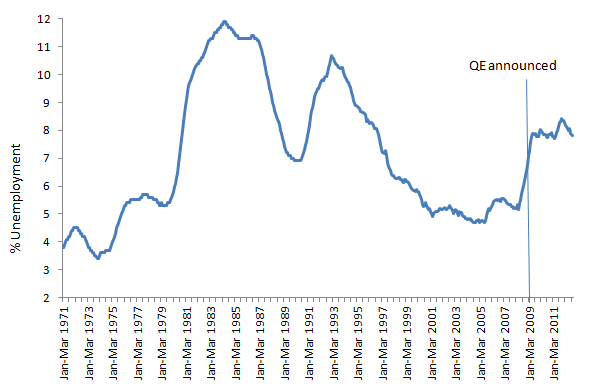
Figure 7. UK: Rate of unemployment
Unemployment appears to have stabilised shortly after the introduction of QE as shown in Figure 7. Whether that was attributable to QE is not clear. Even if it was, QE has not been capable of reducing the level of unemployment. Therefore, QE is likely to be an inadequate policy for reducing the rate of unemployment.
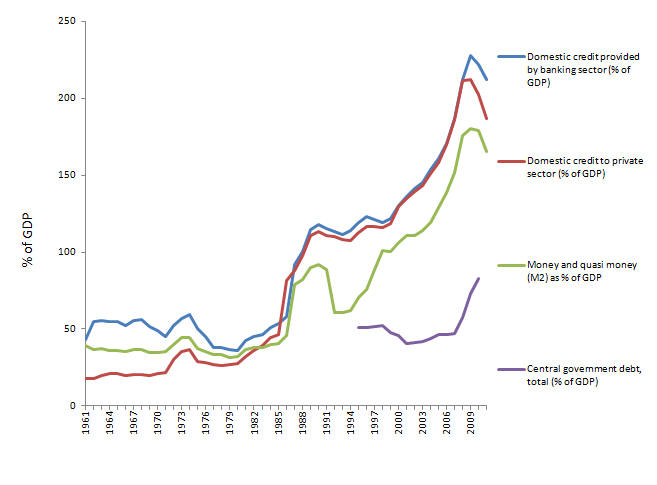
Figure 8. UK Growth of credit, money and government debt relative to GDP (Source: World Bank)
Figure 5, revealed that QE was followed by a decline in the total amount of bank credit. Therefore, it was not bank lending that stimulated the economy. As shown in REF _Ref345868704 \h Figure 8, the most likely stimulus responsible for halting the decline in GDP and rise of unemployment was the fiscal stimulus. The amount of public debt increased from 57% of GDP in 2008 to 73% of GDP in 2009.
One of the main objectives of QE was to raise the rate of inflation to 2.0%, following a period of falling prices. Prices did rise again after QE as shown in Figure 9. However, prices had already started to rise in February 2009, before the Bank of England announced QE in March. Also, given that QE did not increase bank lending and the money supply, it is unlikely to have contributed to the stabilisation of the rate of inflation.
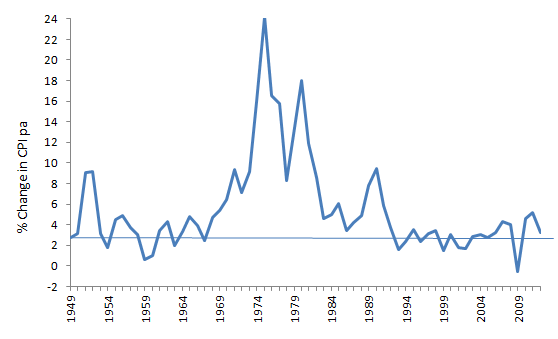
Figure 9. Change in the Consumer Price Index
Another aspect of the economy that needs to be addressed is the current account deficit. Figure 10 reveals that the UK has experienced current account deficits since the mid 1980’s. As discussed above, current account deficits are a generated by the growth of domestic sources of monetary growth, such as bank credit, in excess of the growth of national savings. If the UK monetary system is to be stable and sustainable in the long term, it must be able to balance the current account and halt the growth of foreign debt.
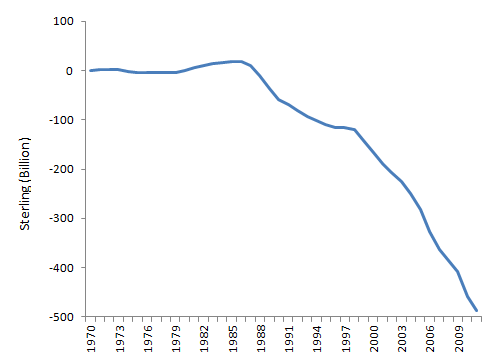
Figure 10. UK: Accumulated current account balance
Objectives of monetary policy
The Bank of England Act, 1998, states that the objectives of the Bank of England are to maintain price stability and, subject to that, support the economic policy of Her Majesty’s Government including its objectives for growth and employment. Also, the Bank is required to contribute to protecting and enhancing the stability of the financial systems of the United Kingdom.
The financial system cannot be stable while debt is growing faster than the remainder on the economy. Also, it cannot be stable while foreign debt continues to rise. Furthermore, while demand has been growing in the economy, a growing proportion of that demand has been directed at imports. That shift to imports has lowered the possible rates of economic growth in the economy and raised the rates of unemployment.
Unconventional policy measures
Just because monetary policy has been conventional for the last 30 years does not mean that they are correct, or are the optimum monetary policy for the UK. The so called “conventional” monetary policy has been beneficial for the banking system. The banking system has a strong desire to continue the prosperity it has been enjoying. However, conventional policy has raised the economy’s debt beyond its capacity repay that debt. In is now in the best interest of the banking system to ensure that the economy grows as fast, if not faster than debt. Otherwise, the economy may not be able to service its debt.
If the wider economy were in control monetary policy, it would seek to lower the ratio of debt to GDP. Therefore, from the perspective of the banking system and the wider economy, it is now in their common interest to ensure that GDP grows faster than debt.
Also, it is desirable to lower the rate of unemployment and reduce the fiscal deficit. Higher economic growth would reduce unemployment, raise tax revenues and reduce expenditure on social security, thereby reducing the fiscal deficit.
Such an outcome is unlikely if the only source of monetary growth is bank credit. As we have saw in REF _Ref345849260 \h Figure 4, monetary growth from bank credit alone has meant that the rate of growth of debt has exceeded the rate of economic growth in the UK since the early 1980’s. Therefore, it is necessary to allow monetary growth to come from a source that can raise GDP more effectively, such as international trade.
My proposal for an unconventional policy measure is in two parts. The first part allows monetary growth from international trade and permits the growth of bank credit, provided that it does not cause expenditure to exceed income and raise foreign debt. The second part provides incentives to the banking system to drive the exchange rate to a level at which the demand for domestic produces is sufficient to meet the governments targets of employment and economic growth while maintaining price stability.
Monetary growth from international trade
To consider the first part, it is necessary to assume, initially, that the exchange rate is fixed. To ensure that banks do not drive the economy into debt, banks would be required to link the growth of their lending to the growth of their net foreign exchange holdings (foreign assets less foreign liabilities). For example, banks may be authorised to lend GBP 10 for every unit increase in their net foreign reserve holdings. This unit of foreign exchange may be a single currency, such as the Euro, or a basket of currencies. At least part of these foreign reserves would be held in an account that could be used to settle interbank transactions.
Banks would be encouraged to purchase foreign currency to add to their foreign reserves. These reserves would allow them to increase their lending. However, as they increase their lending, the additional demand would raise imports and deplete their foreign reserves which in turn would constrain them from further lending, until their reserves were replenished.
Banks would not be able to borrow to increase their foreign reserves. It would be possible for foreign capital to enter the economy, raise bank foreign reserves and thereby increase bank lending. Once the demand for domestic credit was being met, interest rates would decline and the lower interest rates would discourage foreign investment in domestic financial assets. As it did so, the economy would move towards a situation where interest rates would decline to a level that would neutralise foreign investment. At that point, the banking system would be able to sustain its lending from the growth of national savings. In that situation, the economy would not be increasing its foreign debt and would be sustaining a balanced current account.
We may now remove the requirement for fixed exchange rates and provide incentives to the banking system to drive the exchange rate to a level that would attain a desired level economic growth and employment, while maintaining price stability.
For example, banks may be allowed to lend GBP 10 for every unit of foreign exchange, provided that inflation was less than 2% and economic growth was sufficient to ensure that unemployment was less than 4%. For every 1% that inflation exceeded 2% or unemployment exceeds 4%, the amount that banks may lend per unit of foreign currency would be reduced by GBP 1. Thus, if inflation were 4% and unemployment were 6%, then banks would be permitted to increase their lending by GBP 6 per unit of foreign currency. To maximise their profits and lending relative to their foreign reserve holdings, the banks would drive the exchange rate to a level that would attain the growth and employment target and do so in such a manner that would minimise the inflationary effects.
This approach would ensure that the Government’s objectives of price stability, employment, economic growth and financial and monetary stability were met[4].
Leigh Harkness
Impact of the floating exchange rate system on economic growth, wages, employment and trade.
USA Australia New Zealand Philippines
Last update: 12 February 2013